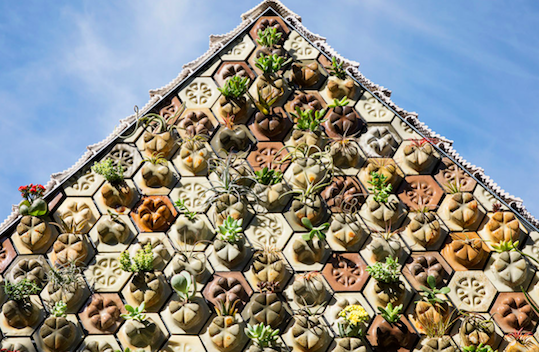Startup Emerging Objects has used the 3D printing of recycled material to create the “Cabin of Curiosities”. A proof of concept as part of a research project, the cabin, built in a backyard in Oakland, is made up of 3D printed tiles which have pockets for vegetation.
Although we’ve seen many examples of 3D printed homes, nothing is quite as “at one” with nature as the Cabin of Curiosities. The cabin is a result of a research project by Ronald Rael and Virginia San Fratello.
Rael is a professor at the University of California Berkeley and San Fratello at San Jose State University. Together they co-founded the architecture studio Rael San Fratello and created Emerging Objects, a 3D printing focused thinktank (or MAKEtank, as they refer to it).
Emerging Objects’ latest architectural research endeavor involved using up-cycling and custom 3D printed cladding in an effort to address the housing shortage in the San Francisco Bay Area, California.
The cabin was constructed after Oakland City Council eased the restrictions on constructing secondary housing units (due to the housing emergency). Now above board planning wise, the one-room Cabin of Curiosities was constructed in a residential backyard.
“We’re building this from our kitchen table, printing parts and testing solutions in real time,” said San Fratello. The cabin’s 3D printed components include tables and chairs, but more impressively, tiles which holds succulents and other plants.

Could you Live in a Cabin of Curiosities?
The exterior of the structure is composed of thousands of tiles. There are two tile types, each with a unique aesthetic and function. The entrance of the Cabin of Curiosities s flanked by ceramic tiles that each contain pockets in which plants can grow.
Additionally, there is Emerging Objects’ seed stitch tile which looks similar to a knitted jumper. These also boast space for vegetation, and have a handmade look through the use of a rapid printing process.
Interior walls of the cabin are lines with translucent, glowing white “Chroma Curl” tiles made from a plastic derived from corn. The resulting interior offers a welcoming place to curl up and sleep.
“These are not just investigations into testing materials for longevity or for structure, but also a study of aesthetics. We see the future as being elegant, optimistic, and beautiful,” explains Rael.
All of the tiles are up-cycled from waste products. Emerging Objects also uses open-source tools and off-the-shelf 3D printers. However, being surrounded by so many plants, it’s cause to wonder whether the 3D printed tiles offer sufficient bug protection inside the cabin.
Want to find out more about Emerging Objects and the unique 3D printing projects? Visit the website. Or, read more about other buildings made using 3D printing on All3DP.
Source: The Architect’s Newspaper

License: The text of "3D Printed Cabin of Curiosities Aims to Address Housing Shortage" by All3DP is licensed under a Creative Commons Attribution 4.0 International License.